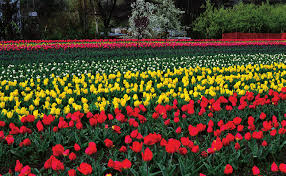GRICULTURAL PROFILE OF DISTRICT KHANEWAL
AGRICULTURAL PROFILE OF DISTRICT KHANEWAL
AGRICULTURAL PROFILE OF DISTRICT KHANEWAL
April 28, 2019
BRIEF HISTORY AND INTRODUCTION:
K
hanewal has a rich and vibrant history which can be traced back to the early 1900s. Khanewal is famous for its cotton growing industry. Daha are regarded as the initial settlers and founders of Khanewal. Khagga is the largest caste of Khanewal.
Historically Khanewal is an old city having its earliest foundations laid by the British Empire owing to its importance as a railway junction. The city was a junction of the Wazirabad-Khanewal railway line and provided a connection to the city of Karachi via Lahore. Its straight roads show that it is a well planned town by the British people. The earliest settlers are said to be the Dahas who have the ‘Khan’ in their names and the city was named after them as Khan-e-wal. Khanewal was declared district in 1985. Most of the Niazi pathan migrants are living in Khanewal.
The District Khanewal comprises four tehsiles, namely Khanewal,Kabir Wala, Jahanian and Mian Channu.It is an agricultural city and is located in Pakistan’s ‘Cotton belt’ – an area covering Khanewal, Multan and Bahawalnagar. Over the last forty to fifty years industry has also been established in and around the city. Sir William Roberts established cotton trading and ginning installations in the area known as Brooke Bond which is now called Unilever, a company that specialises in making tea.There are over 900 workers employed by Unilever.
The people of Khanewal are mostly engaged in agricultural activities which are the main source of income for the people of the district. Other industries in Khanewal include chemical production and oil extraction.
Total Area 205,344 km2 (79,284 sqmi)
Population 91,379,615
Density 450/km2(1,200/ sq mi)
Number of Districts 36
Climate:
AVERAGE RAINFALL & TEMPERATURES
MONTHS
J
F
M
A
M
J
J
A
S
O
N
D
Aver.
Mean
Rainfall
15
35
24
13
18
48
138
84
43
9
11
9
37.25
Max. Temp.
19
22
27
33
39
39
35
35
34
32
27
21
30.25
Min. Temp.
7
11
16
20
26
28
27
27
25
20
14
8
19.08
AGRICULTURE STATISTICS:
Crop
Area(Ha)
Production (Tonnes)
Yield T/Ha
2007-08
2008-09
2007-08
2008-09
2007-08
2008-09
Wheat
211600
229500
567300
714300
2.68
3.11
Rice
22700
30400
40200
57500
1.77
1.89
Fodder
80300
79600
1895400
1926900
23.60
24.20
Fruits
22538
22488
248295
254957
11.01
11.33
Vegetables
8726
8037
89855
92056
10.29
11.45
AGRICULTURAL PROFILE OF DISTRICT KHANEWAL
April 28, 2019
BRIEF HISTORY AND INTRODUCTION:
K
hanewal has a rich and vibrant history which can be traced back to the early 1900s. Khanewal is famous for its cotton growing industry. Daha are regarded as the initial settlers and founders of Khanewal. Khagga is the largest caste of Khanewal.
Historically Khanewal is an old city having its earliest foundations laid by the British Empire owing to its importance as a railway junction. The city was a junction of the Wazirabad-Khanewal railway line and provided a connection to the city of Karachi via Lahore. Its straight roads show that it is a well planned town by the British people. The earliest settlers are said to be the Dahas who have the ‘Khan’ in their names and the city was named after them as Khan-e-wal. Khanewal was declared district in 1985. Most of the Niazi pathan migrants are living in Khanewal.
The District Khanewal comprises four tehsiles, namely Khanewal,Kabir Wala, Jahanian and Mian Channu.It is an agricultural city and is located in Pakistan’s ‘Cotton belt’ – an area covering Khanewal, Multan and Bahawalnagar. Over the last forty to fifty years industry has also been established in and around the city. Sir William Roberts established cotton trading and ginning installations in the area known as Brooke Bond which is now called Unilever, a company that specialises in making tea.There are over 900 workers employed by Unilever.
The people of Khanewal are mostly engaged in agricultural activities which are the main source of income for the people of the district. Other industries in Khanewal include chemical production and oil extraction.
Total Area 205,344 km2 (79,284 sqmi)
Population 91,379,615
Density 450/km2(1,200/ sq mi)
Number of Districts 36
Climate:
AVERAGE RAINFALL & TEMPERATURES
MONTHS
J
F
M
A
M
J
J
A
S
O
N
D
Aver.
Mean
Rainfall
15
35
24
13
18
48
138
84
43
9
11
9
37.25
Max. Temp.
19
22
27
33
39
39
35
35
34
32
27
21
30.25
Min. Temp.
7
11
16
20
26
28
27
27
25
20
14
8
19.08
AGRICULTURE STATISTICS:
Crop
Area(Ha)
Production (Tonnes)
Yield T/Ha
2007-08
2008-09
2007-08
2008-09
2007-08
2008-09
Wheat
211600
229500
567300
714300
2.68
3.11
Rice
22700
30400
40200
57500
1.77
1.89
Fodder
80300
79600
1895400
1926900
23.60
24.20
Fruits
22538
22488
248295
254957
11.01
11.33
Vegetables
8726
8037
89855
92056
10.29
11.45

Comments
Post a Comment